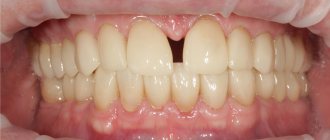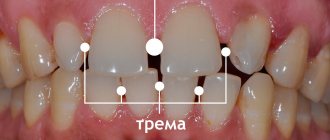Unnoticeable at first glance, anatomical formations located in the oral cavity (frenulum) can affect a child’s ability to attach to the breast in infancy, speech and bite, the purity of pronunciation of words and phrases, and the aesthetics of a smile.
Our clinic “White Whale” carries out timely diagnosis of oral health in children of any age using a specially developed technique. Parents who contact us for the first time often become regular clients. The result of cooperation with us is healthy children, satisfied parents.
Oral anatomy
There are three frenulums in the mouth. The most important and insidious is the frenulum of the tongue, attached from the underside of the tongue to the sublingual space. The frenulum of the upper lip is woven into the mucous membrane of the gums above the level of the anterior incisors. The frenulum of the lower lip has a connection similar to the upper one.
A shortened frenulum is diagnosed in infancy, in infants (usually this concerns the frenulum of the tongue). Abnormal development of the frenulum of the upper and lower lips is usually discovered in the dental chair or at an appointment with a speech therapist.
Description of the problem
The frenulum is a part of the oral mucosa that connects the gum to the middle of the inner surface of the upper or lower lips. Its function is to limit the movement of the lips and provide additional attachment to the jaw bones. The problem arises when the bridles are attached incorrectly or are not long enough.
Anomalies of the frenulum in children most often lead to difficulties with chewing and sucking, and disturbances in the development of speech function. For adults, problems are associated with increased tension on the edges of the gums. Gum pockets appear, gums begin to recede, and the bite becomes disturbed (with age, the procedure for correcting it becomes more difficult). A short frenulum of the upper lip provokes the development of excessive spaces between the front teeth. The anomaly contributes to the accumulation of food deposits under the lips and on the surface of the teeth.
If the pain is associated with damage to the frenulum
The hyoid frenulum is a mucous membrane that connects the tongue to the base of the mouth. Inflammation can be caused by:
- Diseases occurring in the oral cavity - stomatitis, gingivitis, periodontitis;
- Using incorrect hygiene products: toothpaste, toothbrush, mouthwash;
- Allergies caused by taking medications.
Inflammation of the frenulum under the tongue can also occur as a result of injury to it during brushing teeth, eating (too hot or cold foods), talking loudly, sharply biting the tongue, or careless handling of cutlery.
The reason why it hurts under the tongue may also be a physiological feature. In cases where the frenulum is short from birth, the likelihood of damage increases significantly, and discomfort can occur even while eating.
What can you do
A visit to the dentist cannot be avoided if the frenulum under the tongue hurts. The doctor will examine the damage and prescribe treatment. At home, especially if you can’t immediately visit a specialist, in order to relieve pain, you can rinse your mouth:
- Soda solution (a teaspoon per glass of chilled boiling water);
- Chamomile or sage decoction;
- Preparations: Stomatofit, Rotokan, Chorophyllipt.
Also, if the frenulum under the tongue is inflamed, it is recommended to treat the affected area with Iodinol or place a cotton swab dipped in sea buckthorn oil at the damaged area. Such measures can only be used in cases where you know for sure that the cause of the pain under the tongue is an inflamed frenulum.
Short frenulum of the tongue
The frenulum of the tongue is a special fold of the oral mucosa, which stretches in the form of an arc from approximately the middle of the tongue to the base of the gums in the area of the lower front incisors. The frenulum of the tongue serves as an additional means of attaching the tongue to the floor of the mouth. Shortening of the frenulum of the tongue is an anomaly in which the upper end of the frenulum is not in the middle of the tongue, but much closer to the tip or even at the very tip of the tongue. It can be complete when the tongue is completely attached to the floor of the mouth and partial when the frenulum is shortened.
A short frenulum of the tongue in medical terminology is called Ankyloglossia.
Sign of a short frenulum of the tongue:
- Heart-shaped tongue in an elevated position
- Inability to extend the tongue so that the tip is sharp
- The tongue curls down when it moves forward
- Difficulty in the act of swallowing, the chewing process (in children, impaired sucking function)
- Impaired pronunciation of sounds and changes in diction
- Bite pathology
- Periodontal diseases
Determining on your own whether you have a tongue tie or not can be difficult because... with a slight shortening of the frenulum, the symptoms are “erased.” Therefore, it is better to undergo an examination by a dentist or orthodontist in our dental center and make sure that everything is in order.
Indications for lingual frenuloplasty:
A short frenulum of the tongue in infancy leads to various disorders: impaired breastfeeding, poor weight gain, early cessation of breastfeeding and, as a consequence, significant retardation in growth and development. This pathology in infants can be detected in the maternity hospital by a pediatric neonatologist. In infants, the lingual frenulum, which is an avascular and muscleless cord, is cut with scissors without suturing, followed by placing the child to the chest for better wound healing.
After simply cutting the frenulum of the tongue with scissors, a rough scar may form, which will also require plastic surgery of the frenulum of the tongue when the child grows up.
In older children, the structure of the frenulum changes (it becomes more dense, vessels appear in it), so they are indicated for surgical intervention - plastic surgery of the frenulum of the tongue.
In preschool children, frenulum pathology is usually detected by a speech therapist. This is due to the organic type of dyslalia, in which the child does not pronounce palatal, hissing and whistling sounds due to limited tongue mobility. A speech therapy examination reveals that the child cannot stick out his tongue or reach the upper incisors with the tip of his tongue. It should be understood that after plastic surgery of the frenulum of the tongue, independent normalization of speech does not occur, therefore, children with speech pathology require a course of corrective speech therapy classes.
Orthodontic indications for plastic surgery of the lingual frenulum include restraining the growth of the lower jaw due to ankyloglossia, which can cause the incisors to tilt inward. In addition, the high attachment of the lingual frenulum makes it difficult to use orthodontic structures. Therefore, before starting orthodontic treatment, tongue frenuloplasty is recommended.
Correction of the tongue frenulum can also be indicated for an adult patient at the stages of orthopedic treatment. Excessive mobility of sublingual tissues can lead to the removal of dentures from the lower jaw during speaking and chewing. Currently, plastic surgery of the lingual frenulum is very relevant when planning prosthetics on implants, because Ankyloglossia can lead to the development of peri-implantitis - disruption of tissue nutrition around the implant, exposure of the implant coils and subsequent loss.
In case of periodontal diseases associated with an abnormal development of the lingual frenulum, namely pathological pockets in the anterior part of the lower jaw, recession, pathological mobility of teeth, plastic surgery of the lingual frenulum may be necessary for preventive purposes.
Plastic frenulum of the tongue
Surgeries for ankyloglossia include frenulotomy (dissection of the lingual frenulum) and frenuloplasty (plasty of the lingual frenulum).
Plastic surgery of the lingual frenulum can be performed either traditionally or using a surgical laser. Tongue frenuloplasty is performed on an outpatient basis using local anesthesia.
In the classic version of lingual frenuloplasty, careful excision of old scars (if the frenulum was cut in infancy) and mucous cord is performed, the formation of a submucosal flap and the transfer of the attachment site of the lingual frenulum. At the conclusion of surgical plastic surgery of the frenulum of the tongue, several self-absorbing sutures are applied. In the process of plastic surgery of the lingual frenulum, it is necessary to monitor the condition of the mouths of the ducts of the sublingual and submandibular salivary glands in order to avoid their damage during incision and suturing.
Laser treatment has a number of clinical advantages compared to traditional dentistry, such as bacteriological and bacteriostatic effects, coagulation (no postoperative bleeding), ergonomics, precision, filigree, no need for sutures and the possibility of performing microsurgical operations, more comfortable conditions for the patient, providing rapid recovery, and most importantly, a sharp decrease in pain response and rapid wound healing compared to traditional methods.
The operation involves local anesthesia. In the process of laser plastic surgery of the frenulum of the tongue, the doctor directs the tip of the device onto the frenulum, which forms a focused light beam that “dissolves” the fold. The duration of the operation without anesthesia is 3-5 minutes. No seams are used. A bandage is applied to the wound (medicines that accelerate healing).
The operation performed using a laser provides comfortable and extremely safe conditions for obtaining the best treatment results for patients. This is especially important when it comes to children's health.
Recommendations after surgery:
- In the first 2 hours after frenuloplasty, you are not allowed to eat;
- In the next 3-4 days, it is recommended to exclude irritating foods (sour, spicy, salty, hard) from the diet and maintain speech rest;
- For 7 days, treat the oral cavity with antiseptic solutions after meals. Solcoseryl, sea buckthorn oil, etc. are placed in the wound area.
Pain due to inflammation of the salivary glands
In cases where a person feels pain on both sides of the tongue, the cause may be inflammation of the sublingual salivary gland. It arises as a result of:
- Complications of another disease (inflammation of the tonsils, acute respiratory viral infections, anemia, vitamin deficiency, dental diseases);
- Insufficient hygiene;
- Obstruction of salivary flow caused by stones or pathogens.
The main symptoms indicating inflammation of the salivary gland:
- Dry mouth – it always seems like there is not enough saliva;
- Pain that is observed not only under the tongue, but also in the ear area;
- Redness of the mucous membrane, thickening or swelling under the tongue;
- Putrid taste.
If you observe such signs in yourself, you should immediately go to the dentist and undergo a course of therapy. Otherwise, an abscess may develop or the disease may become chronic.
If you have a problem similar to that described in this article, be sure to contact our specialists. Don't diagnose yourself!
Why you should call us now:
- We will answer all your questions in 3 minutes
- Free consultation
- The average work experience of doctors is 12 years
- Convenient location of clinics
Single contact phone number: +7
Make an appointment
At what age is it better to have frenuloplasty?
The sooner an anomaly in the shape and structure of the frenulum is identified, the more painless the operation to correct it will be. Accordingly, there will be many times fewer unpleasant consequences for the body.
- infancy: this is the best option. The pathology is usually diagnosed in the maternity hospital during examination of the newborn. At the age of up to 9 months, the membrane of the tongue has not yet had time to acquire blood vessels and does not have nerve endings, which means that the procedure for its correction will be quick and painless. The baby will almost immediately begin to eat well and stop being capricious. In children who have undergone frenuloplasty before one year of age, their appetite is quickly restored, since the sucking reflex is not impaired,
- 1-3 years: this period is the best time to visit the dentist for the first time; he will be the one who will be able to diagnose the problem and take action. Trimming the frenulum at this age will also be quite painless and will not harm the jaw system,
- 5-8 years: if the pathology of the frenulum was not resolved at an earlier age, then this can be done when the baby teeth fall out, but it is better before the baby teeth are replaced with permanent ones. A specialist needs no more than ten minutes to eliminate the pathology. But it is worth noting that at this age the child can already speak, which means he will have to additionally visit a speech therapist to retrain the baby to pronounce a number of sounds.
Treatment
Having established the causes of inflammation of the tongue, the specialist prescribes treatment. In case of inflammation of the salivary glands, the purulent contents are initially removed, then antibacterial agents are injected into the ducts, and the patient is also prescribed antibiotics or sulfonamide drugs orally.
As a rule, therapy is accompanied by rinsing (in each case the doctor selects the optimal solution) and physiotherapy: UHF, Sollux and others. For fever and general malaise, paracetamol or ibuprofen is prescribed.
Surgical treatment methods are used extremely rarely. The operation is performed if there are stones in the duct and they cannot be removed in any other way.
If you experience unpleasant symptoms or discover inflammation or swelling under your tongue, do not look for what it might be. Go to a qualified dentist, he will examine the oral cavity, make a diagnosis, and prescribe adequate therapy. Perhaps pain in the sublingual space is a symptom of another serious disease and consultation with an appropriate specialist will be required.
Monitor the condition of your teeth and mucous membranes, visit the dentist regularly, promptly treat inflammation of the ENT organs and ARVI - such preventive measures will minimize the possibility of inflammation and pain.
Methods for fixing the problem
Correction of lip frenulum is carried out on an outpatient basis, under the influence of conduction or local infiltration anesthesia.
There are three ways:
1. Dissection of the frenulum (frenulotomy) – the frenulum is dissected with a transverse incision, which is pulled together and stitched in the longitudinal direction.
2. Excision of the frenulum (frenulectomy) - the frenulum is stretched using a clamp and then excised between the front teeth. The mucous membrane bordering the incision is peeled off, while the edges of the wound are brought closer to each other by bringing them together and stitching them together.
3. Frenuloplasty consists of moving the place of attachment of the frenulum: a median vertical incision is made, at both ends of which additional incisions are made at an acute angle. Triangular flaps peel off and counter movement occurs. They are stitched together horizontally.
Causes
There are several factors that can provoke the inflammatory process. In most cases, the causes of the disease are:
- wearing tight synthetic underwear, which can injure the delicate skin in the groin area;
- allergic dermatitis, which develops when choosing inappropriate intimate cosmetics, lubricants, condoms;
- failure to comply with intimate hygiene rules;
- complications of diabetes and other endocrine diseases;
- obesity, which provokes a decrease in the body's defenses;
- alcohol abuse and frequent smoking;
- frequent stress, overwork, nervous tension.
Often inflammation occurs not as an independent disease, but as a complication of balanitis. The risk of developing an inflammatory process also increases if the frenulum of the foreskin is too small. During intimacy, tears or microcracks appear on it, in which pathogenic microorganisms can begin to multiply.
Postitis symptoms, signs in boys, guys and men
What are the main symptoms and signs of posthitis in men and boys? Which posthitis clinic ? Itching of the glans penis . Burning sensation on the head of the penis . Pain in the head of the penis. Swelling, redness of the head of the penis. Pain, pain, discomfort during sex in the area of the head of the penis. Difficulty opening the head. Decreased sensitivity of the head. Weakening of erection. Cracks in the foreskin. Ulcers and ulcers on the head.
Causes of frenulum rupture
Life is filled with different situations in which you can break the frenulum of the tongue. This often happens as a result of:
- injuries - for example, from a fall;
- impact - hitting your face can cause injury to the frenulum;
- sudden movement of the tongue.
If there is a small tear in the frenulum, there is no need to panic; it will go away on its own after some time. If the gap is deep, you need to contact your dentist, who will tell you how to relieve the pain and, if necessary, prescribe treatment.
Severe injuries may require surgery.
Treatment methods
Treatment of inflamed interdental papillae is aimed at eliminating increased sensitivity and pain. This may include:
- rinsing the mouth with antiseptic solutions and chamomile decoction,
- applications of anti-inflammatory gels and ointments,
- taking antibacterial drugs,
- professional teeth cleaning,
- coagulation of overgrown tissues.
The treatment regimen is chosen by the doctor taking into account the diagnosis, clinical picture, and individual characteristics of the patient’s oral cavity.
Phimosis, narrowing of the foreskin
Phimosis is a terrible disease. A predisposing factor in the development of posthitis is congenital or acquired narrowing of the opening of the foreskin - phimosis . With a disease such as diabetes mellitus, or in the elderly and elderly, phimosis of the penis can develop even with regular high-quality washing of the glans. With balanitis, the foreskin is hyperemic and swollen, erosions and purulent plaque appear on its inner surface and head, a guy or a man is bothered by itching and pain when trying to have sexual intercourse. Sometimes the head is not exposed , the penis swells, becomes hyperemic, redness is noted, and lymphadenitis of the inguinal lymph nodes appears. A severe complication of phimosis is gangrene of the penis , which can result in complete tissue necrosis. The man is left without a penis. And this is already a difficult situation!
Therapeutic exercises
There are alternative methods that allow you to do without surgery, for example, a set of special exercises for developing the frenulum of the tongue.
- Reach alternately to the upper and lower lips.
- Extend your tongue and make pendulum movements from cheek to cheek.
- Suck your tongue to the roof of your mouth and let go, imitating a horse clopping its hooves.
- Place your tongue on each cheek with your mouth closed.
- Smile with your mouth open.
- Stretch your lips.
- Pull your lips into a tube, pretending to kiss.
To achieve results, you need to perform the exercises every day for 5 - 10 minutes. It is important to remember that this method is suitable for correcting mild disorders; more severe pathologies require surgical intervention.
A little about the complexities of the anatomy of the tongue
The frenulum of the tongue is a thin bridge that connects the lower part of the oral cavity to the tongue. Its main function is to maintain the correct position of the tongue in the mouth by ensuring its movement, which is directly related to diction and the ability to pronounce individual sounds.
To see the frenulum, it will be enough to lift the tongue upward. It is located in the middle of the tongue, connecting to the base of the gums, as if holding this organ in place.
A normal frenulum does not cause discomfort
The length of the frenulum of an adult is approximately 3 cm. If this figure is less or the frenulum of the tongue is located in such a way that when it is raised, it is strongly stretched, we can talk about a short frenulum. In turn, it will interfere with the free rotation, protrusion and elevation of the tongue.
Symptoms of inflammation
Symptoms of inflammation of the foreskin are quite pronounced and manifest themselves:
- The appearance of unpleasant sensations such as itching and burning.
- Feeling of tension when opening.
- Redness of the foreskin.
- The occurrence of swelling.
- Accumulation of pus, as well as smegma, inside the preputial sac.
In general, a person’s well-being deteriorates, weakness, a constant feeling of irritation and, at the same time, increased excitability appear.
If you do not start treating diseases in a timely manner, various complications may begin, expressed by:
- Reduced sensitivity of the head.
- Violation of potency.
- The appearance of cracks on the penis.
- The appearance of ulcers.
- Enlarged inguinal lymph nodes.
Symptoms and diseases of the foreskin:
- Swelling of the foreskin
- Foreskin rupture
- Inflammation of the foreskin
- Redness of the foreskin
- Foreskin removal
- Narrowing of the foreskin
- Ulcers on the foreskin
- Herpes on the foreskin
- Red spots on the foreskin
- Sores on the foreskin
- Dryness of the foreskin










